Last-Minute NYC Holiday Gift Guide 🎁
We’ve created a holiday gift guide with presents for the intrepid New Yorker that should arrive just in time—


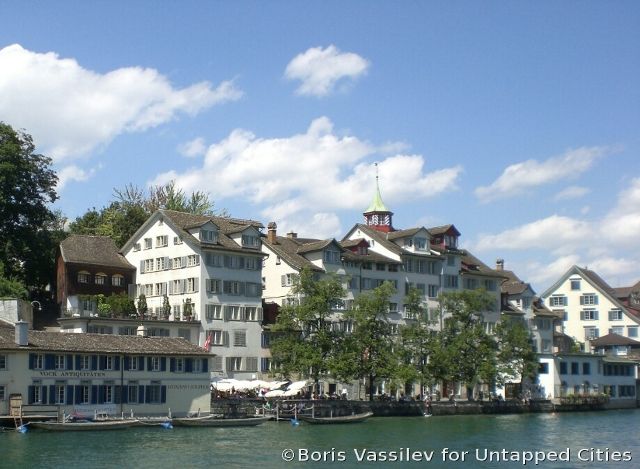
There is a city by a lake in Europe that will give you a bicycle, and send you on its well bicycle-laned streets to explore, stand in awe, and rarely get lost. In a very real way, the “ZàÆ’ ¼ri rollt” bike-sharing program is a direct application of the Zurich, and perhaps Swiss in general, mentality and lifestyle.
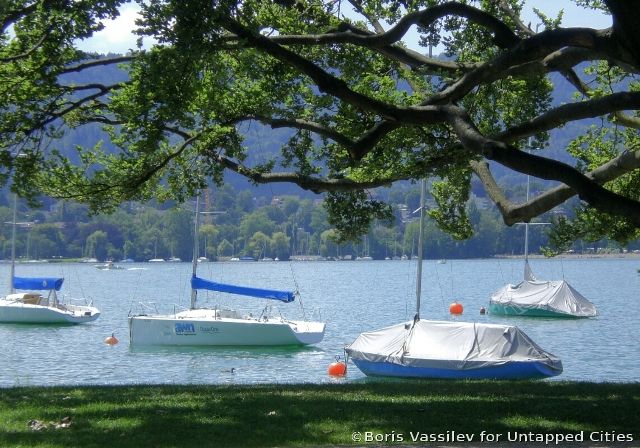 Boats harbored on Lake Zurich.
Boats harbored on Lake Zurich.
At first glance, the bicycles are unimpressive and look unwieldly, but closer inspection reveals numerous high-end components, hub dynamos and a clever built-in wheel lock. The bicycles are not slow, but neither are they fast nor feline like their speed-obsessed cousins from the same 1000+ Swiss Franc price bracket. Many of the same things can be said about the vehicular population of the city, where there are few exotic sports cars, but many high-end German town and family cars–equally unaffordable and fast, but the latter being more demure and less eye candy.
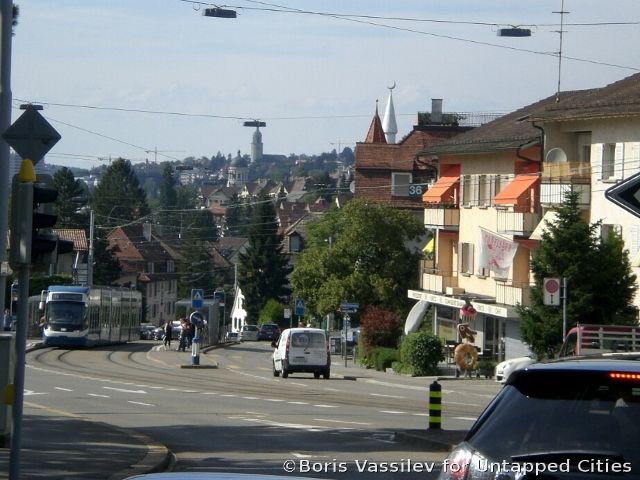 One of Zurich’s many hilly streets; great when you’re going downhill on your bike.
One of Zurich’s many hilly streets; great when you’re going downhill on your bike.
The Zurich bike-sharing system is free to use, requiring only a valid ID and a temporary 20 Swiss Franc deposit. The transaction is dealt with a bank-like efficiency and careful reminders about the many rules (“Back by 9:30” – like your first date). The cost of operating such a system, with several locations, many employees and the maintenance of the bicycles themselves, is all covered by the city of Zurich, which seems to operate on a philosophy of constant maintenance and building projects. One way to contain wealth within an urban system is to re-invest in large scale projects that are sourced from and benefit the citizenry directly.
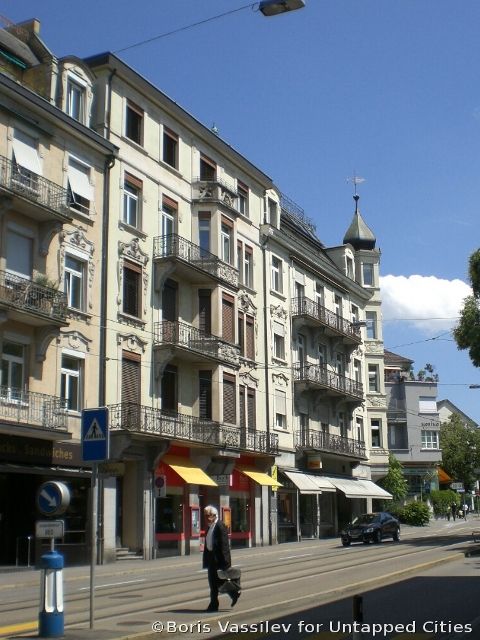 Streets in the city are generally very clean. Bike lanes are typically between the sidewalk and the street.
Streets in the city are generally very clean. Bike lanes are typically between the sidewalk and the street.
The bicycles are safe, with the highest speed setting just fast enough to get a pleasantly thrilling velocity when coasting down one of Zurich’s many long, gently-sloped hills, and the wide tires make short work of gravel or uneven road surfacing. Zurich loves its safety. Policemen direct traffic at the city’s many construction zones, patrol all parks and side avenues, and smile a lot in a totally genuine, if unnerving, way. Houses in the neighborhoods surrounding the massive ZàÆ’ ¼richsee (Lake Zurich), around which the city is built, come in all styles, deco to modern to all-glass to Old World Swiss, and are surrounded by impressive, but not imposing walls, as if politely declining unwanted visitors.
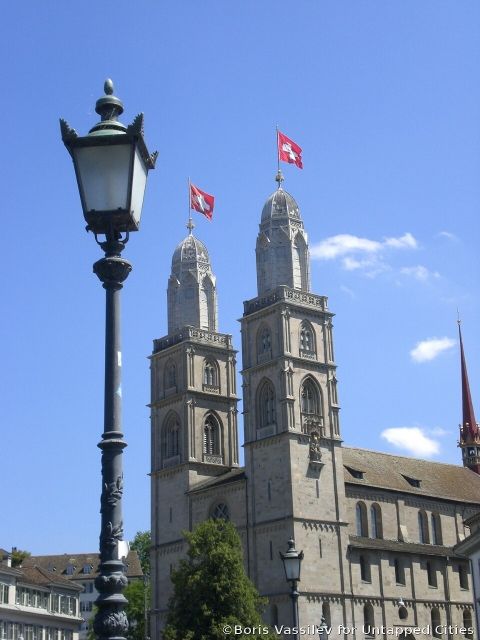 GrossmàÆ’ ¼nster church in the historical part of Zurich.
GrossmàÆ’ ¼nster church in the historical part of Zurich.
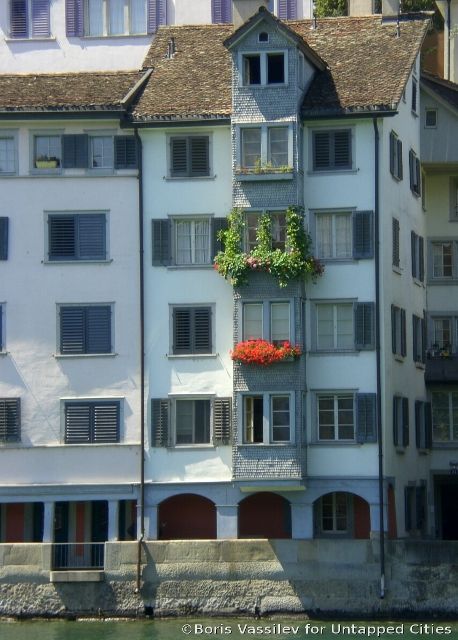 Flowered walls in the historical part of the city.
Flowered walls in the historical part of the city.
Each bicycle has a considerable basket welded to the back, perfect for a few bottles of wine, some fresh bread, salted meats, artisanal cheese and a pickle jar (or whatever you take on a picnic). Zurich residents are addicted to lounging on the grass in their parks. Throughout the day, whether a work one or not, the parks and lawn strips lining most of the lake and neighborhoods are filled with residents, even the red light district (the shockingly sanitary red light district, which contains a great skate park and is very family-oriented).
There is a permeating sense of leisure and surety of existence among the old and young, hookah-smoking or soccer playing, some even looking like odd Brooklyn hipster parent transplants, with sleeve tattoos and trucker hats, but even their nonconformist image is often tempered by wedding rings and toddlers. Zurich is not a Stepford community, but the high quality of life and control seems to have tempered even the usual misfits, in a place where even the graffiti that commonly graces European cities seems tame, hiding in corners and small.
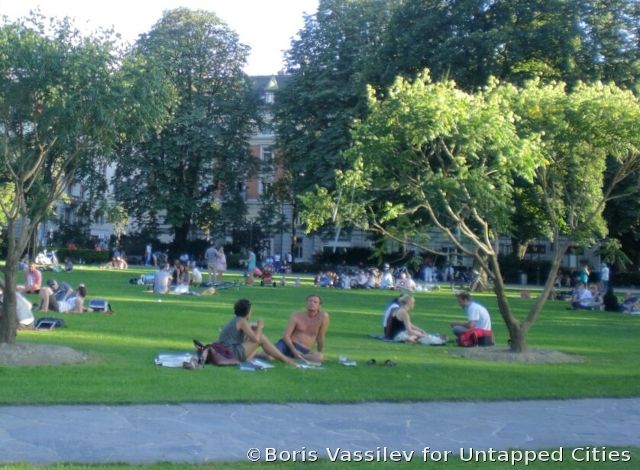 Lounging on the grass is a favorite Zurich pastime activity.
Lounging on the grass is a favorite Zurich pastime activity.
Zurich has created a self-perpetuating system of life, and of bicycle. It is safe, it is expensive but not gaudy, it affords leisure and promotes forward-thinking (the bicycle share system boasts employing the unemployed and encouraging a healthy, green lifestyle). So where’s the catch?
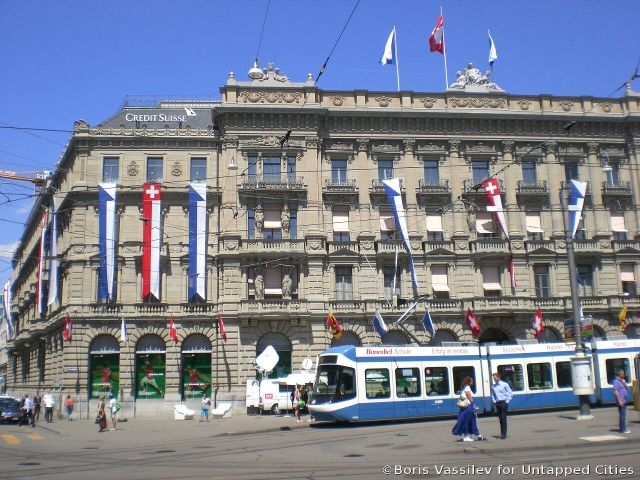 White and Blue are the colors of Zurich’s coat of arms; the Swiss flag is red flag with a white, bold, equilateral cross in the center. Both are ubiquitous.
White and Blue are the colors of Zurich’s coat of arms; the Swiss flag is red flag with a white, bold, equilateral cross in the center. Both are ubiquitous.
One could argue that the organization and safety of the city can easily slide a little bit into the predictable and, in the absolute best sense of the word, boring. This becomes obvious when visiting the Landesmuseum, Zurich’s museum to Swiss history, and one of the many places readily accessible by bicycle. Other than the thorough and quite organized permanent collection featuring the historical circumstances leading to Zurich’s current place in the world, there is also currently a temporary exhibition on Postmodernism. Walking through the displays, charting the movement as it developed from a means of re-inventing old art, through dealing with a post-industrial world, to the glory days of epilepsy-inducing late 80s music videos, it becomes apparent that this entire strain of thought and desire, toward the chaos, grime, the explosively unusual, is somehow missing from the city outside.
Zurich is like a postcard, beautiful to experience and see, though slightly offputting at how put-together it really is. Whether this is a function of the highly-educated, paced way of life that most residents seem to lead, or a top-down result of the high degree of government control is impossible to tell, as the two seem to have become co-dependently intertwined.
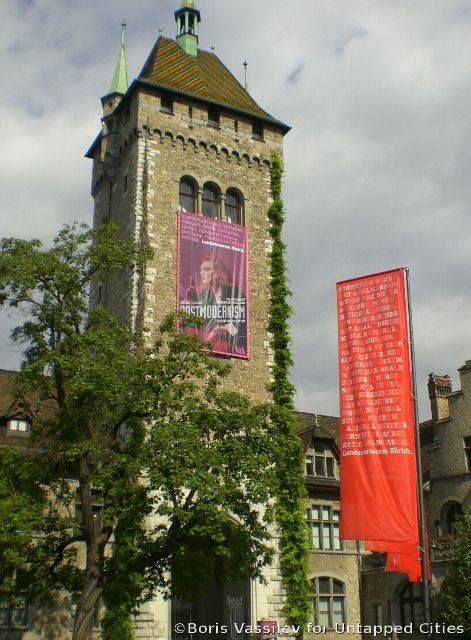 The Landesmuseum ZàÆ’ ¼rich, advertising its Postmodernism exhibition.
The Landesmuseum ZàÆ’ ¼rich, advertising its Postmodernism exhibition.
Landesmuseum ZàÆ’ ¼rich
Museumstrasse 2, 8021 ZàÆ’ ¼rich, Schweiz [MAP]
+41 44 218 65 11
Follow the author on Tumblr.
Subscribe to our newsletter